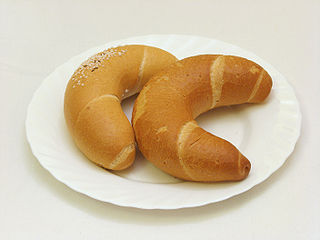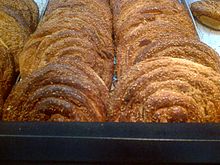
Dough is a thick, malleable, sometimes elastic paste made from grains or from leguminous or chestnut crops. Dough is typically made by mixing flour with a small amount of water or other liquid and sometimes includes yeast or other leavening agents, as well as ingredients such as fats or flavorings.

Kifli, kiflice, kifle, or kipferl is a traditional yeast bread roll that is rolled and formed into a crescent before baking.

Iraqi cuisine is a Middle Eastern cuisine that has its origins in the ancient Near East culture of the fertile crescent. Tablets found in ancient ruins in Iraq show recipes prepared in the temples during religious festivals—the first cookbooks in the world. Ancient Mesopotamia was home to a sophisticated and highly advanced civilization, in all fields of knowledge, including the culinary arts.

Tulumba or Bamiyeh is a deep-fried dessert found in Egypt, Turkey and the regional cuisines of the former Ottoman Empire. It is a fried batter soaked in syrup, similar to jalebis or churros. It is made from unleavened choux pastry dough piped with a pastry bag using an open star or similar tip. It is first deep-fried to golden colour and then sugar-sweet syrup is poured over it when still hot. It is eaten cold.

Levantine cuisine is the traditional cuisine of the Levant, in the sense of the rough area of former Ottoman Syria. The cuisine has similarities with Egyptian cuisine, North African cuisine and Ottoman cuisine. It is particularly known for its meze spreads of hot and cold dishes, most notably among them ful medames, hummus, tabbouleh and baba ghanoush, accompanied by bread.

Tsoureki also known as šurēk, čöreg, čʿorek, katʿnahuncʿ, çörək (Azerbaijani), çyrek (Albanian), kozunak, cozonac (Romanian) or paskalya çöreği (Turkish) is a sweet holiday bread made with flour, milk, butter, eggs, and sugar and commonly seasoned with orange zest, mastic resin, or mahlab. Lampropsomo, a variation of tsoureki commonly called "Greek Easter bread," is made by Greek communities during Easter, not only in Greece, but also in other countries with Greek communities. It is also called Armenian Easter bread and gets eaten during Easter in Armenia and the Armenian diaspora.
Armenian cuisine includes the foods and cooking techniques of the Armenian people and traditional Armenian foods and drinks. The cuisine reflects the history and geography where Armenians have lived and where Armenian empires existed. The cuisine also reflects the traditional crops and animals grown and raised in Armenian-populated or controlled areas.

Cardamom breads, including the Finnish pulla and Swedish kardemummabröd and kardemummabullar, are a group of enriched breads or pastry flavored with cardamom. They are eaten throughout the year, typically with coffee or tea.

Baklava is a layered dessert made of filo pastry sheets, filled with chopped nuts, and sweetened with syrup or honey.

The poppy seed roll is a pastry consisting of a roll of sweet yeast bread with a dense, rich, bittersweet filling of poppy seed. An alternative filling is a paste of minced walnuts, or minced chestnuts.

Qurabiya also ghraybe, ghorayeba, ghoriba, ghribia, ghraïba, gurabija, ghriyyaba, or kourabiedes and numerous other spellings and pronunciations, is a shortbread-type biscuit, usually made with ground almonds. Versions are found in most Arab and Ottoman cuisines, with various different forms and recipes. They are similar to polvorones from Andalusia.

Tahinopita is a Cypriot cake flavoured with sesame paste. Variations on the recipe include quickbread versions with chemical leaveners, yeasted versions, and phyllo layer versions. As most varieties contain no dairy, eggs, or oil, they are popular during Lent and can be considered vegan.

Middle Eastern cuisine or West Asian cuisine includes a number of cuisines from the Middle East. Common ingredients include olives and olive oil, pitas, honey, sesame seeds, dates, sumac, chickpeas, mint, rice and parsley, and popular dishes include kebabs, dolmas, falafel, baklava, yogurt, doner kebab, shawarma and mulukhiyah.

Açma is a slightly sweet yeast pastry from Turkish cuisine that is often offered as street food. Common varieties are bread rolls, dough rings, and dough rolls, often with additional savory or sweet fillings.













